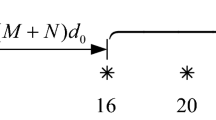Abstract
This paper focuses on developing a hole-filling technique for difference co-array (DCA) of the co-prime array and its variants. In existing methods, obtaining DCA uses vectorization of the covariance matrix obtained from received signals employing Khatri–Rao product. For the co-prime array (CA) family, the DCA so obtained consists of a set of virtual contiguous elements and multiple non-uniform virtual elements. Till now, the DOA estimation from the CA family considers only virtual contiguous elements of the DCA, leaving out “holes” and other virtual non-uniform elements. This existence of holes results in a substantial decrease in consecutive degrees of freedom than expected. To address the issue of holes (in the DCA of CA family), this paper extends the original DCA of augmented CA to obtain a new virtual DCA called \(ACA^{EDCA}\). The \(ACA^{EDCA}\) is virtually hole-free. Compared to DCA of the existing CA family, the resulting \(ACA^{EDCA}\) has a larger effective DOF. Therefore, the aperture length compared to other existing variants of the co-prime array is also larger. Simulations compare performances of 9 element ACA using \(ACA^{EDCA}\) with few other arrays of the CA family. With and without using \(ACA^{EDCA}\), the ACA respectively resolves 43 and 14 sources. Sliding extended CA and relocating extended CA respectively determine 22 and 25 sources. Similarly, the root-mean-square error performance of ACA using \(ACA^{EDCA}\) is better compared to others.




Similar content being viewed by others
Data Availability
Data sharing does not apply to this article as no datasets were generated or analyzed during the current study.
References
E. BouDaher, Y. Jia, F. Ahmad, M.G. Amin, Multi-frequency co-prime arrays for high-resolution direction-of-arrival estimation. IEEE Trans. Sig. Process. 63(14), 3797–3808 (2015)
F. Dong, L. Xu, X. Li, Particle filter algorithm for doa tracking using co-prime array. IEEE Commun. Lett. 24(11), 2493–2497 (2020)
J. He, L. Li, T. Shu, Sparse nested arrays with spatially spread orthogonal dipoles: high accuracy passive direction finding with less mutual coupling. IEEE Trans. Aerosp. Electron. Syst. 57(4), 2337–2345 (2021)
F. Knaepkens, A. Cuyt, W.-S. Lee, D.I.L. deVilliers, Regular sparse array direction of arrival estimation in one dimension. IEEE Trans. Anten. Propag. 68(5), 3997–4006 (2020)
P.Pal , P.P. Vaidyanathan, Coprime sampling and the MUSIC algorithm, in 2011 digital signal processing and signal processing education meeting (DSP/SPE), pp.289–294, IEEE, (2011)
P. Pal, P.P. Vaidyanathan, Nested arrays: a novel approach to array processing with enhanced degrees of freedom. IEEE Trans. Sig. Process. 58(8), 4167–4181 (2010)
S. Qin, Y.D. Zhang, M.G. Amin, Generalized coprime array configurations for direction-of-arrival estimation. IEEE Trans. Sig. Process. 63(6), 1377–1390 (2015)
Q. Shen, W. Liu, W. Cui, S. Wu, Extension of co-prime arrays based on the fourth-order difference co-array concept. IEEE Sig. Process. Lett. 23(5), 615–619 (2016)
J. Shi, G. Hu, X. Zhang, Y. Xiao, Symmetric sum coarray based co-prime mimo configuration for direction of arrival estimation. AEU Int. J. Electron. Commun. 94, 339–347 (2018)
J. Shi, G. Hu, X. Zhang, F. Sun, W. Zheng, Y. Xiao, Generalized co-prime mimo radar for doa estimation with enhanced degrees of freedom. IEEE Sens. J. 18(3), 1203–1212 (2018)
J. Shi, F. Wen, T. Liu, Nested mimo radar: coarrays, tensor modeling, and angle estimation. IEEE Trans. Aerosp. Electron. Syst. 57(1), 573–585 (2021)
Z. Tan, Y.C. Eldar, A. Nehorai, Direction of arrival estimation using co-prime arrays: a super resolution viewpoint. IEEE Trans. Sig. Process. 62(21), 5565–5576 (2014)
P.P. Vaidyanathan, P. Pal, Sparse sensing with co-prime samplers and arrays. IEEE Trans. Sig. Process. 59(2), 573–586 (2011)
X. Wang, X. Wang, Hole identification and filling in \(k\)-times extended co-prime arrays for highly efficient doa estimation. IEEE Trans. Sig. Process. 67(10), 2693–2706 (2019)
J. Wang, H. Xu, G.J.T. Leus, G.A.E. Vandenbosch, Experimental assessment of the coarray concept for doa estimation in wireless communications. IEEE Trans. Anten. Propag. 66(6), 3064–3075 (2018)
Z. Weng, P.M. Djurić, A search-free doa estimation algorithm for coprime arrays. Digit. Sig. Process. 24, 27–33 (2014)
M. Yang, A.M. Haimovich, X. Yuan, L. Sun, B. Chen, A unified array geometry composed of multiple identical subarrays with hole-free difference coarrays for underdetermined doa estimation. IEEE Access 6, 14238–14254 (2018)
W. Zheng, X. Zhang, Y. Wang, M. Zhou, Q. Wu, Extended coprime array configuration generating large-scale antenna co-array in massive MIMO system. IEEE Trans. Veh. Technol. 68(8), 7841–7853 (2019)
W. Zheng, X. Zhang, J. Li, J. Shi, Extensions of co-prime array for improved doa estimation with hole filling strategy. IEEE Sens. J. 21(5), 6724–6732 (2021)
Author information
Authors and Affiliations
Corresponding author
Additional information
Publisher's Note
Springer Nature remains neutral with regard to jurisdictional claims in published maps and institutional affiliations.
Rights and permissions
About this article
Cite this article
Raiguru, P., Sahu, A.K., Gouda, A. et al. Hole-Free DCA for Augmented Co-Prime Array. Circuits Syst Signal Process 41, 2977–2987 (2022). https://doi.org/10.1007/s00034-021-01909-0
Received:
Revised:
Accepted:
Published:
Issue Date:
DOI: https://doi.org/10.1007/s00034-021-01909-0




